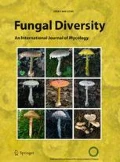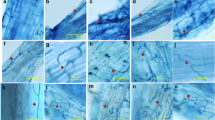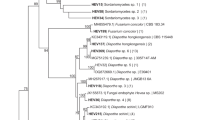Abstract
Holcus lanatus is a grass that grows in humid, often waterlogged soils in temperate zones around the world. The purpose of this work was to identify fungal endophytes associated with its roots and leaves, and to describe the diversity and spatial distribution patterns found in its mycobiota. Holcus plants were sampled at 11 locations in western and northern Spain, and endophytes were isolated from leaves and roots of each plant. Morphological and molecular methods based on the ITS1-5.8SrRNA-ITS2 sequence were used for isolate identification. In total, 134 different species were identified, 77 occurred in leaves, 79 in roots, and 22 were common to both organs. The dominant species of the mycobiota were isolated from roots and leaves, and were species generally considered as multi-host endophytes. The species richness was similar in leaves and roots, but the composition of isolates from roots varied more among locations than in leaf mycobiotas, suggesting that soil characteristics may have strongly influenced the root mycobiota. Significant variations with respect to the composition of their mycobiota among different locations indicate that beta diversity is a first order factor governing the richness and distribution of the endophytic mycobiota in grasses.


Similar content being viewed by others
References
Arnold AE (2007) Understanding the diversity of foliar endophytic fungi: progress, challenges, and frontiers. Fungal Biol Rev 21:51–66
Arnold AE, Lutzoni F (2007) Diversity an host range of foliar fungal endophytes: are tropical leaves biodiversity hotspots? Ecology 88:541–549
Arnold AE, Maynard Z, Gilbert GS, Coley PD, Kursar TA (2000) Are tropical fungal endophytes hyperdiverse? Ecol Lett 3:267–274
Bacon CW, Porter JK, Robbins JD, Luttrell ES (1977) Epichloë typhina from toxic tall fescue grasses. Appl Environ Microbiol 34:576–581
Bills GF (1996) Isolation and analysis of endophytic fungal communities from woody plants. In: Erdlin SC, Carris LM (eds) Endophytic fungi in grasses and woody plants. APS, USA, pp 31–65
Colwell RK (2005) EstimateS: statistical estimation of species richness and shared species from samples. Version 7.5. Persistent URL <purl.oclc.org/estimates>
Crozier J, Thomas SE, Aime MC, Evans HC, Holmes KA (2006) Molecular characterization of fungal endophytic morphospecies isolated from stems and pods of Theobroma cacao. Plant Pathol 55:783–791
Curlevski NJA, Chambers SM, Anderson IC, Cairney JWG (2009) Identical genotypes of an ericoid mycorrhiza-forming fungus occur in roots of Epacris pulchella (Ericaceae) and Leptospermum polygalifolium (Myrtaceae) in an Australian sclerophyll forest. FEMS Microbiol Ecol 67:411–420
Duong LM, Jeewon R, Lumyong S, Hyde KD (2006) DGGE coupled with ribosomal DNA phylogenies reveal uncharacterized fungal phylotypes on living leaves of Magnolia liliifera. Fungal Divers 23:121–138
Fang Z, Ouyang Z, Hu L, Wang X, Zheng H, Lin X (2005) Culturable airborne fungi in outdoor environments in Beijing, China. Sci Total Environ 350:47–58
Fletcher LR, Harvey IC (1981) An association of a Lolium endophyte with ryegrass staggers. NZ Vet J 29:185–186
Freeman EM (1902) The seed fungus of Lolium temulentum L., the darnel. Philos Trans R Soc Lond, B 196:1–27
Fröhlich J, Hyde KD, Petrini O (2000) Endophytic fungi associated with palms. Mycol Res 104(10):1202–1212
Gange AC, Dey S, Currie AF, Sutton BC (2007) Site-and species specific differences in endophyte occurrence in two herbaceous plants. J Ecol 95:614–622
Guerin D (1898) Sur la presence d’un Champignon dans l’lvraie. J Bot 12:230–238
Guo LD, Hyde KD, Liew ECY (2000) Identification of endophytic fungi from Livistonia chinensis based on morphology and rDNA sequences. New Phytol 147:617–630
Guo LD, Hyde KD, Liew ECD (2001) Detection and taxonomic placement of endophytic fungi within frond tissues of Livistona chinensis based on rDNA sequences. Mol Phylogenet Evol 20:1–13
Huang WY, Cai YZ, Hyde KD, Corke H, Sun M (2008) Biodiversity of endophytic fungi associated with 29 traditional Chinese medicinal plants. Fungal Divers 33:61–75
Huang WY, Cai YZ, Surveswaran S, Hyde KD, Corke H, Sun M (2009) Molecular phylogenetic identification of endophytic fungi isolated from three Artemisia species. Fungal Divers 36:69–88
Hubbard CE (1984) Grasses. A guide to their structure, identification, uses and distribution in the British Isles. Penguin, London
Hyde KD, Soytong K (2008) The fungal endophyte dilemma. Fungal Divers 33:163–173
Kuldau G, Bacon C (2008) Clavicipitaceous endophytes: their ability to enhance resistance of grasses to multiple stresses. Biol Control 46:57–71
Lacap DC, Hyde KD, Liew ECY (2003) An evaluation of the fungal ‘morphotype’ concept based on ribosomal DNA sequences. Fungal Divers 12:53–66
Li WC, Zhou J, Guo SY, Guo LD (2007) Endophytic fungi associated with lichens in Baihua mountain of Beijing, China. Fungal Divers 25:69–80
Magurran AE (2004) Measuring biological diversity. Blackwell, Oxford
Malinowski DP, Belesky DP (2000) Adaptations of endophyte-infected coolseason grasses to environmental stresses: mechanisms of drought and mineral stress tolerance. Crop Sci 40:923–940
Mitchell AM, Strobel GA, Hess WM, Vargas PN, Ezra D (2008) Muscodor crispans, a novel endophyte from Ananas ananassoides in the Bolivian Amazon. Fungal Divers 31:37–43
Morakotkarn D, Kawasaki H, Seki T (2006) Molecular diversity of bamboo-associated fungi isolated from Japan. FEMS Microbiol Lett 266:10–19
Neubert K, Mendgen K, Brinkmann H, Wirsel SGR (2006) Only a few fungal species dominate highly diverse mycofloras associated with the common reed. Appl Environ Microbiol 72:1118–1128
Nikolcheva LG, Bärlocher F (2005) Seasonal and substrate preferences of fungi colonizing leaves in streams: traditional versus molecular evidence. Environ Microbiol 7:270–280
Nilsson RH, Ryberg M, Abarenkov K, Sjökvist E, Kristiansson E (2009) The ITS region as a target for characterization of fungal communities using emergent sequencing technologies. FEMS Microbiol Lett 296:97–101
Portnoy JM, Barnes CS, Kennedy K (2008) Importance of mold allergy in asthma. Curr Allergy Asthma Rep 8:71–78
Raghukumar C (2008) Marine fungal biotechnology: an ecological perspective. Fungal Divers 31:19–35
Redman RS, Dunigan DD, Rodriguez RJ (2001) Fungal symbiosis from mutualism to parasitism: who controls the outcome, host or invader? New Phytol 151:705–716
Rosa LH, Vaz ABM, Caligiorne RB, Campolina S, Rosa CA (2009) Endophytic fungi associated with the Antarctic grass Deschampsia antarctica Desv. Polar Biol 32:161–167
Rungjindamai N, Pinruan U, Choeyklin R, Hattori T, Jones EBG (2008) Molecular characterization of basidiomycetous endophytes isolated from leaves, rachis and petioles of the oil palm, Elaeis guineensis, in Thailand. Fungal Divers 33:139–161
Sánchez Márquez S, Bills GF, Zabalgogeazcoa I (2007) The endophytic mycobiota of the grass Dactylis glomerata. Fungal Divers 27:171–195
Sánchez Márquez S, Bills GF, Zabalgogeazcoa I (2008) Diversity and structure of the fungal endophytic assemblages from two sympatric coastal grasses. Fungal Divers 33:87–100
Schardl CL, Leuchtmann A, Spiering MJ (2004) Symbioses of grasses with seedborne fungal endophytes. Annu Rev Plant Biol 55:315–340
Schulz B, Boyle C (2005) The endophytic continuum. Mycol Res 109:661–686
Schulz B, Guske S, Dammann U, Boyle C (1998) Endophyte-host interactions II. Defining symbiosis of the endophyte-host interaction. Symbiosis 25:213–227
Seena S, Wynberg N, Bärlocher F (2008) Fungal diversity during leaf decomposition in a stream assessed through clone libraries. Fungal Divers 30:1–14
Sieber TN (2007) Endophytic fungi in forest trees: are they mutualists? Fungal Biol Rev 21:75–89
Stone JK, Polishook JD, White JF Jr (2004) Endophytic fungi. In: Mueller GM, Bills GF, Foster MS (eds) Biodiversity of fungi. Inventory and monitoring methods. Elsevier Academic Press, USA, pp 241–270
Tao G, Liu ZY, Hyde KD, Lui XZ, Yu ZN (2008) Whole rDNA analysis reveals novel and endophytic fungi in Bletilla ochracea (Orchidaceae). Fungal Divers 33:101–122
Thompson JD, Gibson TJ, Plewniak F, Jeanmougin F, Higgins DG (1997) The ClustalX windows interface: flexible strategies for multiple sequence alignment aided by quality analysis tools. Nucleic Acids Res 24:4876–4882
Tomita F (2003) Endophytes in Southeast Asia and Japan: their taxonomic diversity and potential applications. Fungal Divers 14:187–204
Toofanee SB, Dulymamode R (2002) Fungal endophytes associated with Cordemoya integrifolia. Fungal Divers 11:169–175
Wei JG, Xu T, Guo LD, Liu AR, Zhang Y, Pan XH (2007) Endophytic Pestalotiopsis species associated with plants of Podocarpaceae, Theaceae and Taxaceae in southern China. Fungal Divers 24:55–74
White IR, Backhouse D (2007) Comparison of fungal endophyte communities in the invasive panicoid grass Hyparrhenia hirta and the native grass Botriochloa macra. Aust J Bot 55:178–185
Wirsel SGR, Leibinger W, Ernst M, Mendgen K (2001) Genetic diversity of fungi commonly associated with common reed. New Phytol 149:589–598
Zamora P, Martínez-Ruiz C, Diez JJ (2008) Fungi in needles and twigs of pine plantations from northern Spain. Fungal Divers 30:171–184
Acknowledgements
Part of this research was financed with research projects GR64 and CSI04A07, granted by the Junta de Castilla y León.
Author information
Authors and Affiliations
Corresponding author
Rights and permissions
About this article
Cite this article
Sánchez Márquez, S., Bills, G.F., Domínguez Acuña, L. et al. Endophytic mycobiota of leaves and roots of the grass Holcus lanatus . Fungal Diversity 41, 115–123 (2010). https://doi.org/10.1007/s13225-009-0015-7
Received:
Accepted:
Published:
Issue Date:
DOI: https://doi.org/10.1007/s13225-009-0015-7




